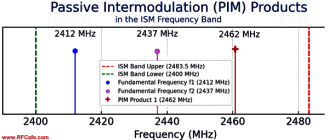Electronics & Technology
- See Full List of AI Topics -
Passive Intermodulation
(PIM) Causes and Mitigation Techniques
Introduction
In the telecommunications industry, the demand for higher data rates and more
efficient networks has led to an increased focus on the quality and performance
of wireless systems. One of the critical challenges affecting network performance
is Passive Intermodulation (PIM). PIM is an unwanted phenomenon that occurs in wireless
communication systems, leading to signal degradation, reduced data throughput, and
interference. Understanding the causes of PIM and implementing mitigation techniques
is essential to maintaining high-quality network performance.

Here is the graph illustrating Passive Intermodulation (PIM)
products in the ISM frequency band, specifically between 2400 MHz and 2483.5
MHz. It shows the fundamental frequencies at 2412 MHz and 2437 MHz, along with
the PIM product (2*f2 - f1 = 2462 MHz) generated by their interaction within the band. The red crosses
represent the PIM products, while the ISM band boundaries are marked with dashed
green lines.
Causes of Passive Intermodulation (PIM)
PIM is a form of distortion that occurs when two or more high-power signals mix
and generate additional frequencies within a passive component, such as connectors,
cables, antennas, or even structural elements. These unwanted frequencies can interfere
with desired signals, leading to degradation in network performance. The primary
causes of PIM are:
Metal-to-Metal Contacts: PIM often occurs at junctions where
different metals come into contact. This is due to the nonlinearities introduced
by imperfect connections between metal surfaces. Inconsistent contact between metallic
surfaces, such as loose connectors or oxidized components, can lead to nonlinear
impedance, causing PIM generation.
Material Nonlinearities: Certain materials used in passive components,
such as connectors and cables, can exhibit nonlinear electrical properties under
high power. Poor-quality materials, or even high-quality materials subjected to
stress or corrosion, can cause nonlinear behavior, contributing to PIM.
Corrosion and Contamination: Corrosion, rust, and oxidation
on metal surfaces increase electrical resistance and create unpredictable nonlinearities,
which can contribute to the generation of intermodulation products. Contaminants
like dust, moisture, or pollution can also exacerbate this effect.
Mechanical Stress: Mechanical stress on cables, connectors,
or other components can affect their structural integrity and increase the likelihood
of PIM. Vibrations, thermal expansion, or compression forces on components can lead
to degradation over time, causing nonlinear performance and contributing to PIM.
Improper Installation: Installation practices can significantly
affect the occurrence of PIM. Improperly torqued connectors, unclean surfaces, or
damaged components during installation can introduce nonlinearities. Even slight
misalignments can lead to weak or inconsistent contacts, resulting in PIM.
Aging of Components: Over time, passive components can degrade
due to environmental factors like temperature, humidity, and physical wear. This
degradation can lead to a higher likelihood of intermodulation products, as the
materials become more prone to nonlinear behavior.
Mitigation Techniques for Passive Intermodulation (PIM)
Addressing PIM requires a combination of careful design, material selection,
installation practices, and ongoing maintenance. Below are some of the key mitigation
techniques:
Use of High-Quality Components: Choosing high-quality, low-PIM-rated
components is crucial to minimizing PIM generation. Manufacturers offer components
specifically designed to minimize intermodulation, such as connectors made from
PIM-resistant materials and low-loss cables. Using these components ensures a lower
risk of PIM in the system.
Proper Installation Practices: Careful installation is essential
to reducing PIM. Ensuring proper torque specifications for connectors, cleaning
all metal surfaces before making connections, and inspecting components for damage
before installation can prevent many of the common causes of PIM. Specialized tools
like torque wrenches are often used to ensure accurate connections.
Regular Maintenance and Inspection: Routine inspection and maintenance
of passive components can help identify and address potential PIM issues before
they affect performance. Checking for signs of corrosion, oxidation, or loose connections
is crucial. Replacing damaged or degraded components promptly can prevent the development
of PIM.
Shielding and Grounding: Proper grounding and shielding of cables,
connectors, and other components can reduce the potential for external interference,
which can contribute to PIM. Grounding helps to dissipate unwanted signals, while
shielding protects components from exposure to electromagnetic interference (EMI).
Minimize Mechanical Stress: Reducing the physical stress on
passive components is critical in minimizing PIM. Proper cable management, avoiding
tight bends, and ensuring adequate strain relief in cables and connectors can help
reduce mechanical stress. Additionally, components should be secured properly to
avoid vibration-induced PIM.
Environmental Protection: Installing passive components in weatherproof
enclosures and protecting them from environmental conditions can help reduce corrosion
and contamination. For outdoor installations, weatherproof connectors and enclosures
that prevent the ingress of moisture, dust, and pollutants can mitigate PIM.
Frequency Planning and Isolation: Designing the system to minimize
the overlap of high-power signals in passive components can reduce the chances of
PIM generation. Proper frequency planning, isolating high-power transmitters from
sensitive receivers, and using filters to block PIM products from reaching critical
parts of the system are effective strategies.
Conclusion
Passive Intermodulation (PIM) is a significant concern in modern wireless communication
systems. It can lead to signal degradation, reduced network performance, and interference,
making it essential to address its causes and implement effective mitigation techniques.
By understanding the sources of PIM, such as metal-to-metal contact, corrosion,
and improper installation, and using high-quality components, following proper installation
practices, and conducting regular maintenance, network operators can minimize the
effects of PIM and ensure the reliable performance of their systems. Addressing
PIM is particularly important as wireless networks continue to evolve, and minimizing
interference becomes critical for meeting the growing demand for high-speed, reliable
communication.
Here is the Python code for the chart, generated by
ChatGPT (not verified)
import matplotlib.pyplot as plt import numpy as np
# Define the ISM frequency range in MHz (for example, 2400 MHz to 2483.5 MHz)
f_min = 2400 # MHz f_max = 2483.5 # MHz
# Define the fundamental frequencies of the two signals causing PIM f1 = 2412
# MHz f2 = 2437 # MHz
# Generate intermodulation products (IP) up to the third order # IP = m*f1 +
n*f2 (where m and n are integers) orders = [(1, 1), (2, -1), (-1, 2), (1, -2),
(-2, 1)] intermod_products = []
for order in orders: m, n = order intermod_freq = m * f1 + n * f2 if f_min <=
intermod_freq <= f_max: intermod_products.append(intermod_freq)
# Set up the plot plt.figure(figsize=(10, 6))
# Plot the ISM band plt.axhline(f_min, color='green', linestyle='--',
label='ISM Band Lower (2400 MHz)') plt.axhline(f_max, color='green', linestyle='--',
label='ISM Band Upper (2483.5 MHz)')
# Plot the fundamental frequencies plt.plot(f1, f1, 'bo', label='Fundamental
Frequency f1 (2412 MHz)') plt.plot(f2, f2, 'bo', label='Fundamental Frequency f2
(2437 MHz)')
# Plot the intermodulation products for i, freq in enumerate(intermod_products):
plt.plot(freq, freq, 'rx', label=f'PIM Product {i+1} ({freq} MHz)' if i == 0
else "")
# Annotate the PIM frequencies for i, freq in enumerate(intermod_products):
plt.text(freq, freq + 5, f'{freq} MHz', fontsize=10, ha='center')
# Set graph limits and labels plt.xlim(f_min - 10, f_max + 10) plt.ylim(f_min
- 10, f_max + 10) plt.xlabel('Frequency (MHz)') plt.ylabel('Intermodulation
Products') plt.title('Passive Intermodulation (PIM) Products in the ISM
Frequency Band')
# Add a legend plt.legend(loc='upper right')
# Show the plot plt.grid(True) plt.show()
 This content was generated by primarily
the ChatGPT (OpenAI), and/or
Gemini (Google), and/or
Arya (GabAI), and/or
Grok (x.AI), and/or DeepSeek artificial intelligence (AI) engine.
Some review was performed to help detect and correct any inaccuracies; however,
you are encouraged to verify the information yourself if it will be used for critical
applications. In some cases, multiple solicitations to the AI engine(s) was(were) used to assimilate
final content. Images and external hyperlinks have also been added occasionally.
Courts have ruled that AI-generated content is not subject to copyright restrictions,
but since I modify them, everything here is protected by RF Cafe copyright. Many
of the images are likewise generated and modified. Your use of this data implies
an agreement to hold totally harmless Kirt Blattenberger, RF Cafe, and any and all
of its assigns. Thank you. Here are the major categories. This content was generated by primarily
the ChatGPT (OpenAI), and/or
Gemini (Google), and/or
Arya (GabAI), and/or
Grok (x.AI), and/or DeepSeek artificial intelligence (AI) engine.
Some review was performed to help detect and correct any inaccuracies; however,
you are encouraged to verify the information yourself if it will be used for critical
applications. In some cases, multiple solicitations to the AI engine(s) was(were) used to assimilate
final content. Images and external hyperlinks have also been added occasionally.
Courts have ruled that AI-generated content is not subject to copyright restrictions,
but since I modify them, everything here is protected by RF Cafe copyright. Many
of the images are likewise generated and modified. Your use of this data implies
an agreement to hold totally harmless Kirt Blattenberger, RF Cafe, and any and all
of its assigns. Thank you. Here are the major categories.
Electronics & High Tech
Companies | Electronics &
Tech Publications | Electronics &
Tech Pioneers | Electronics &
Tech Principles |
Tech Standards Groups &
Industry Associations | Societal
Influences on Technology
|









